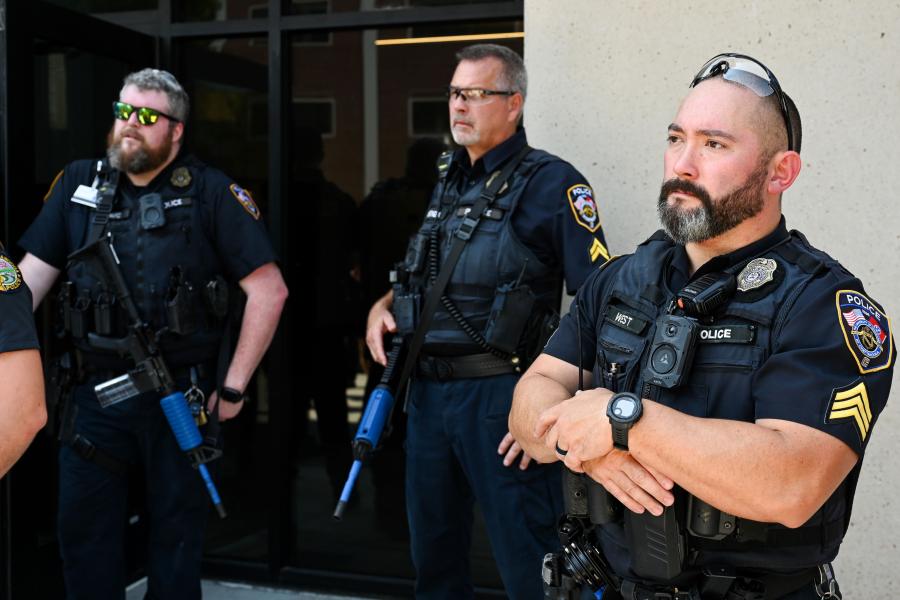
UTC ACTIVE SHOOTER GUIDELINES
Run, Hide, Fight
An active shooter is one or more individuals actively engaged in killing or attempting to kill people in a populated area. The best scenario is to intervene before situations escalate into violence. If you see warning signs in a person’s behavior, please share your concerns.
Active Shooter Response
When Active Shooter events happen, you must be prepared mentally and physically to react. How you react should be based on decision-making specific to the incident. First responders will quickly arrive to help. A UTC-ALERT notification will communicate the latest known location of the threat, along with other important information. You'll need to choose how to respond using your best judgment and one of the three options below.
Run
- Have an escape plan in mind.
- If you’re outside a building near the threat, go to the closest cover immediately.
- If you’re inside a building, know the assailant's location, and have a clear path to an exit - evacuate immediately.
- Try to prevent others from entering the building as you exit.
- Keep your hands empty, visible, and raised, following all instructions from law enforcement and other first responders.
- Tell law enforcement anything you know about the assailant (e.g., location, weapons).
Hide
- If you're unsure that you can safely exit the building or are unsure of the assailant's location, hide.
- Close, lock, and barricade doors and windows.
- Seek cover in an inconspicuous location, out of the view of a potential assailant.
- Silence your cell phone.
- Be as silent as possible.
Fight
- As a last resort and only if your life is in immediate danger, attempt to stop the assailant.
- Attempt to incapacitate the assailant.
- Act with as much physical aggression as possible.
- Improvise weapons or throw items at the assailant.
Be Prepared for Law Enforcement
- Follow all instructions given by law enforcement and other first responders.
- Understand that the first actions by law enforcement will be to address the threat.
- Keep your hands empty, visible, and raised, following all instructions from law enforcement and other first responders.
- Tell law enforcement anything you know about the assailant (e.g., location, weapons).
Active Shooter FAQs
- If an active shooter is outside your building.
- Go to a room that can be locked or barricaded.
- Close, lock, and barricade doors and windows.
- Seek cover in an inconspicuous location.
- Silence your cell phone.
- Be as silent as possible.
- Dial or text 911 and tell the telecommunicator what’s happening and where you are. If you can’t speak, stay on the line so the dispatcher can hear what’s happening.
- Stay in the room until law enforcement evacuates you or until a UTC-ALERT is sent advising "ALL CLEAR".
- If an active shooter is inside the building where you are.
- If the room can be locked, close, lock, and barricade doors and windows.
- If the room can’t be locked, determine if you can safely get to a nearby room that can be closed, locked, and barricaded.
- If the room can't be locked but can be barricaded, close and barricade the doors and windows.
- Seek cover in an inconspicuous location.
- Silence your cell phone.
- Be as silent as possible.
- Dial or text 911 and tell the telecommunicator what’s happening and where you are. If you can’t speak, stay on the line so the dispatcher can hear what’s happening.
- Stay in the room until law enforcement evacuates you or until a UTC-ALERT is sent advising "ALL CLEAR".
- If an active shooter enters your office or classroom.
- Dial or text 911, if able.
- If able, provide the assailant's location and description.
- If you are not able to speak, keep the phone line open so the telecommunicator can hear what’s happening.
- As a last resort and only if your life is in immediate danger, attempt to stop the assailant.
- If the assailant leaves the area, attempt to close, lock, and barricade doors and windows or go to a safe location.
- If you are able and decide to run in an active shooter situation.
- Have an escape plan in mind.
- Keep your hands empty, visible, and raised, following all instructions from law enforcement and other first responders.
- Tell law enforcement anything you know about the assailant (e.g., location, weapons).
- What you should expect from responding law enforcement to an active shooter.
- Law enforcement are trained to proceed as quickly as possible toward the sound of gunfire. Their purpose is to stop the shooter.
- Officers may be in uniform or in plain clothes and armed.
- Keep your hands empty, visible, and raised, following all instructions from law enforcement and other first responders.
- Tell law enforcement anything you know about the assailant (e.g., location, weapons).
- Law enforcement will not stop to assist injured people until there is no longer a threat. Others will follow to treat the injured.